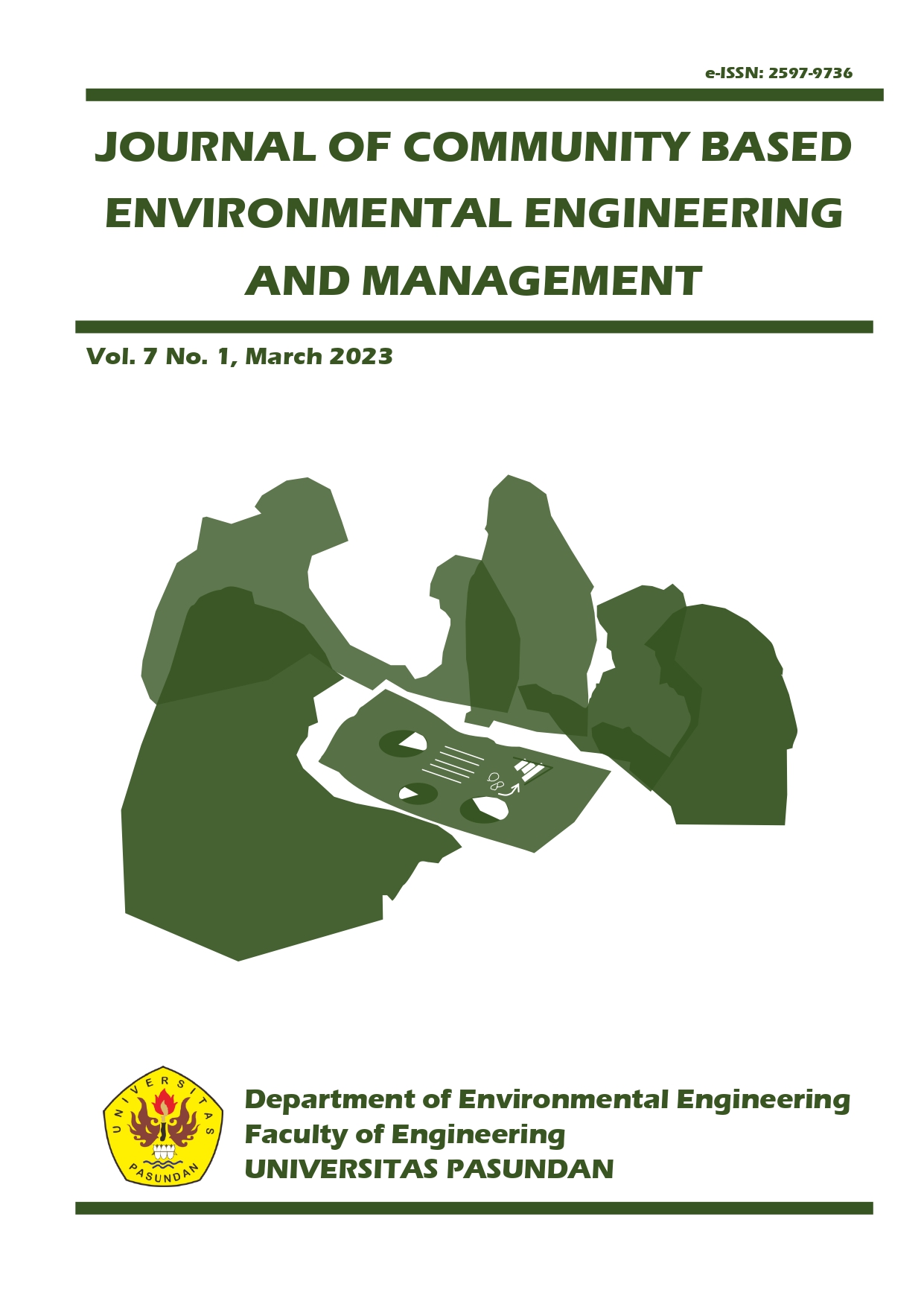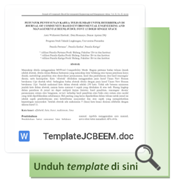Reduction of Chemical Oxygen Demand (COD) and Total Suspended Solid (TSS) Levels in Rubber Wastewater Using Biosand Filter Reactor with Activated Carbon Media Based on the Effect of Residence Time
DOI:
https://doi.org/10.23969/jcbeem.v7i1.6285Keywords:
Waste rubber, COD, TSS Biosand filter-activated carbon, residence timeAbstract
Wastewater from the rubber industry that is not treated optimally can be one of the causes of environmental damage. Initial concentration of COD waste rubber liquid 711 mg/l and TSS 407 mg / l. Biosand Filter with activated carbon can eliminate pathogenic bacteria by passing the sand in the filter and activated carbon will absorb organic substances. This study aims to determine the effectiveness of concentration reduction, COD and TSS, using a reactor with BioSand Filter reactor dimensions used measuring 12 cm x 12 cm x 120 cm and its effect on residence time. Filter Media used are sand, gravel, pumice and activated carbon. The research variable is the residence time in the reactor (10, 30, 50, 70, and 90 minutes). Removal efficiency after being processed using Biosand Filter technology with activated carbon media lowered the concentration of COD and TSS parameters to 93% for COD and 79% for TSS. Test the effect of residence time to reduce the levels of COD and TSS is done by regression test has a value of R2=0.7014 for COD and R2=0.681 for TSS, with tcount > ttable. the results show that the residence time of rubber wastewater in the reactor affect the decrease levels of COD and TSS, and quite effective in eliminating COD and TSS parameters.
Downloads
References
Atima, W.. (2015). BOD dan COD Sebagai Parameter Pencemaran Air Dan Baku Mutu Air Limbah. Biosel Biol. Sci. Educ., 4(1), 83 Doi: 10.33477/Bs.V4i1.532.
BSN. (2004). SNI 06-6989.3-2004: Air dan air limbah- Bagian 3: Cara uji padatan tersuspensi total (Total Suspended Solid, TSS) secara gravimetric.
Direktorat Jenderal Perkebunan. (2021). Luas Areal Kelapa Menurut Provinsi di Indonesia , 2016-2019 Coconut Area by Province in Indonesia, 2016-2019.
Fadhillah, M. and Wahyuni, D.. (2016). Efektivitas Penambahan Karbon Aktif Cangkang Kelapa Sawit (Elaeis Guineensis) dalam Proses Filtrasi Air Sumur. J. Kesehat. Komunitas, 3(2), 93–98, 2016, doi: 10.25311/keskom.vol3.iss2.110.
Halim, P.A.. (2014). Biosand Filter dengan Reaktor Karbon Aktif Dalam Pengolahan Limbah Cair Laundry (Studi Kasus Bung Laundry Makassar). Skripsi: Universitas Hasanuddin.
Harahap, M. R., Amanda, L. D., and Matondang, A. H.. (2020). Analisis Kadar COD (Chemical Oxygen Demand) dan TSS (Total Suspended Solid) pada Limbah Cair dengan Menggunakan Spektrofotometer Uv-Vis. Amina, 2(2), 79–83.
Jin, S., Park, J. H., Yang, W. S., Lee, J. Y., and Hwang, C. W.. (2021). Anti-biofilm ability of garlic extract on Pantoea agglomerans and application to biosand filter. Desalin. Water Treat., 228, 84–91, 2021, doi: 10.5004/dwt.2021.27317.
Kencanawati, C. I. P. K.. (2016). Sistem Pengelolaan AiIr Limbah. Diktat: Universitas Udayana.
Mayasari, R., Purba, E., and Djana, M.. (2020). Penyisihan Kadar Amoniak ( NH3 ) Dalam Limbah Cair Karet Dengan Kombinasi Adsorben Bentonit Dan Zeolit Secara Kontinyu. Seminar Nasional Ilmu Teknik Dan Aplikasi Industri (Sinta).
Nasrullah, S., Hayati, R., and Kadaria, U.. (2014). Pengolahan Limbah Karet Dengan Fitoremidiasi Menggunakan Tanaman Typha Angustifolia. (https://media.neliti.com/media/publications/191120-ID-none.pdf accessed September 2022)
Nugroho, F.L., Rusmaya, D., Yustiani, Y.M., Hafiz, F. I., Putri, R. B. T. (2017). Effect of Temperature on Removal of COD and TSS from Artificial River Water by Mudball Made from EM4, Rice Bran and Clay. Int. J. of Geomate, 12(33), 91-95.
Nuraini, E., Fauziah, T., and Lestari, F.. (2019). Penentuan Nilai BOD dan COD Limbah Cair Inlet Laboratorium Pengujian Fisis Politeknik Atk Yogyakarta. Integr. Lab J., 7(2), 10–15.
Rahmat, B. and Mallongi, A.. (2018). Studi Karakteristik Dan Kualitas Bod Dan Cod Limbah Cair Rumah Sakit Umum Daerah Lanto Dg. Pasewang Kabupaten Jeneponto. J. Nas. Ilmu Kesehat., 1(69), 1–16.
Ramdja, A. F., Halim, M., and Handi, J. (2008). Pembuatan Karbon Aktif Dari Pelepah Kelapa (Cocus nucifera) A. J. Tek. Kim., 15(2), 1–8.
Ratnawati, R. and Al Kholif, M.. (2018). Aplikasi Media Batu Apung Pada Biofilter Anaerobik Untuk Pengolahan Limbah Cair Rumah Potong Ayam. Jurnal Sains & Teknologi Lingkungan, 10(1), 1–14.
Primasari, B., Indah, S., Afrianita, R., and F. Rahmatesa. (2020). Biosand Filter for Removal of Organic Pollutant from Laboratory Wastewater. J. Phys. Conf. Ser., 1625.
Sari Dewi, D., Eko Prasetyo, H. & Karnadeli, E.. (2020). Pengolahan Air Limbah Industri Karet Remah (Crumb Rubber) Dengan Menggunakan Reagen Fenton. Jurnal Redoks, 5(1), 47–57. https://doi.org/10.31851/redoks.v5i1.4120
Suligundi, B. T.. (2013). Penurunan Kadar COD (Chemical Oxygen Demand) Pada Limbah Cair Karet Dengan Menggunakan Reaktor Biosand Filter Yang Dilanjutkan Dengan Reaktor Activated Carbon. J. Tek. Sipil Untan, 13(1), 29–44.
Srimurni, R. R.. (2015). Pengolahan Limbah Cair dengan Menggunakan Biosand Filter. Pasca Sarjana. Fakultas Teknologi Pertanian. Institut Pertanian Bogor.
Yadav, K. K., Mandal, A. K., and Chakraborty, R.. (2018). Biology of Bacterial Biofilms. Biology of Plants Microbes, 61-82, Book Chapter.














